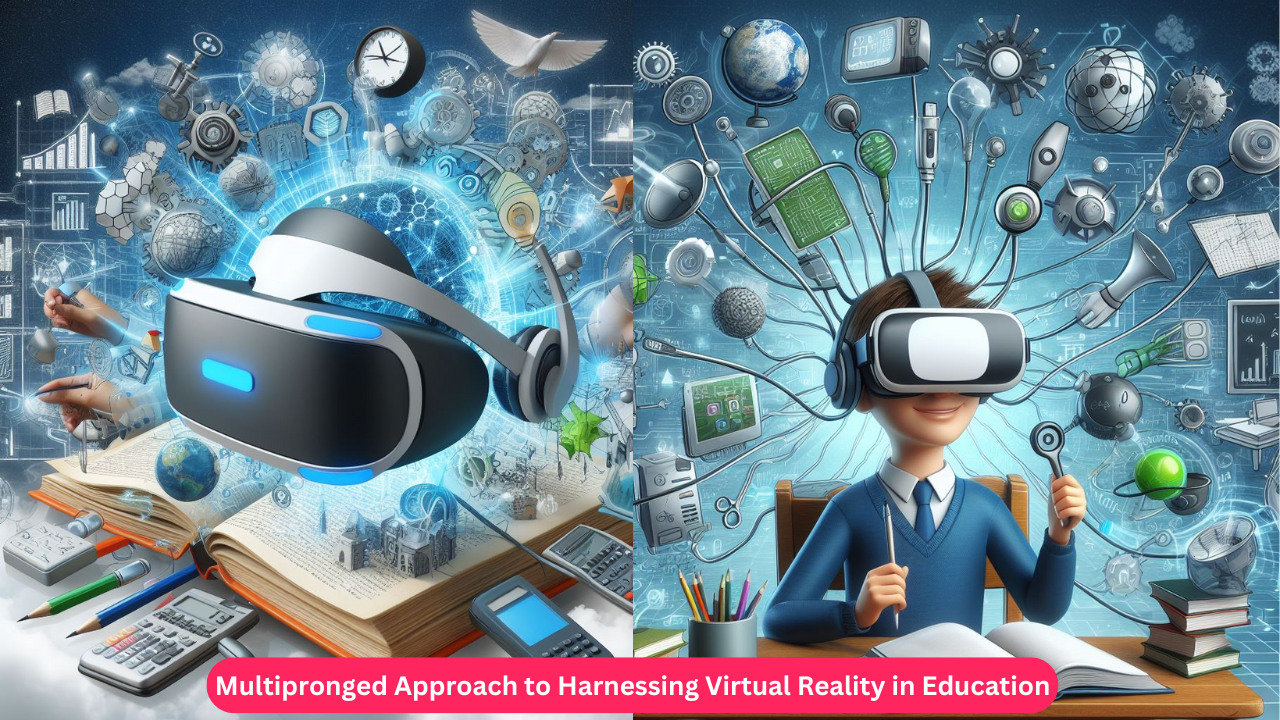Virtual reality in education- In-depth exploration of how a multipronged approach to harnessing virtual reality (VR) can significantly advance quality education, innovation, and research across various educational levels.
A Multipronged Approach to Harnessing Virtual Reality in Education

Introduction
The rapid evolution of technology has revolutionized the way we learn and teach. Virtual Reality (VR), once confined to science fiction, is now a powerful tool that holds immense potential for education. In this article, we delve into the multifaceted impact of VR on primary schools, secondary schools, and colleges, emphasizing its role in enhancing quality education, fostering innovation, and driving research.
1. Quality Education Enhancement Virtual Reality in Education
a. Engaging Learning Experiences
VR provides immersive and interactive learning environments that captivate students’ attention. Whether exploring ancient civilizations, dissecting a virtual frog, or conducting physics experiments, students can engage with content in ways that textbooks and traditional lectures cannot match. This engagement leads to deeper understanding and retention.
b. Personalized Learning Paths
VR allows educators to tailor learning experiences to individual student needs. Students can explore topics at their own pace, revisit complex concepts, and receive real-time feedback. Adaptive VR applications adjust difficulty levels based on student performance, ensuring personalized learning journeys.
c. Inclusive Education
VR transcends physical limitations. Students with disabilities can participate fully in virtual classrooms, overcoming barriers posed by mobility, vision, or hearing impairments. It fosters inclusivity by creating equitable learning opportunities for all.
2. Innovation Acceleration Virtual Reality in Education
a. Design Thinking and Creativity
VR encourages creative problem-solving. Students can design 3D models, simulate architectural structures, or create virtual art galleries. By experimenting in a risk-free environment, they develop critical thinking skills and unleash their creativity.
b. STEM Education Advancements
In science, technology, engineering, and mathematics (STEM) fields, VR offers unparalleled experiences. Imagine exploring the human body at the cellular level, manipulating DNA strands, or simulating chemical reactions. These experiences ignite curiosity and inspire future scientists and engineers.
c. Entrepreneurship and Business Simulations
Business schools can use VR to simulate real-world scenarios. Students can run virtual startups, analyze market trends, and make strategic decisions. Such simulations bridge theory and practice, preparing graduates for the dynamic business landscape.
3. Research and Innovation Nexus
a. Virtual Laboratories Virtual Reality in Education
VR transforms research by providing virtual laboratories. Scientists can simulate experiments, test hypotheses, and visualize complex phenomena. For example, medical students can practice surgeries in VR, refining their skills before entering the operating room.
b. Collaborative Research Networks
VR connects researchers globally. Collaborative virtual environments facilitate interdisciplinary discussions, data visualization, and joint experiments. Researchers from different continents can work together seamlessly, accelerating breakthroughs.
c. Archival and Historical Reconstructions
Historians and archaeologists can recreate historical events or lost civilizations in VR. Imagine walking through ancient Rome or witnessing the signing of pivotal treaties. These reconstructions enrich our understanding of the past.
Virtual Reality in Education
Kalunga, R., & Elshobokshy, F. (2024). A Multipronged Approach to Harnessing Virtual Reality to Advance the HBCU Mission.
Conclusion
A multipronged approach to VR adoption in education involves faculty training, infrastructure development, and curriculum integration. Historically Black Colleges and Universities (HBCUs) have a unique opportunity to lead in this space, ensuring that every student benefits from this transformative technology. By embracing VR, educational institutions can propel quality education, foster innovation, and drive impactful research, ultimately shaping a brighter future for generations to come.
Remember, this is just the beginning. As VR technology continues to evolve, its impact on education will only grow, shaping a more dynamic and inclusive learning landscape.
Virtual Reality in Education
More Articles
Amazing ! Reinforcement Learning from Human Feedback: Bridging AI and Human Intelligence
Exclusive & Elite Insights: Unveiling the Top 10 International School in India 2024
Academic Excellence Unveiled: Saraswati World School Secures Top Spot in Hooghly and Emerges
West Bengal’s Top 25 CBSE Schools: A Pathway to Your Child’s Success
Building a Strong Foundation for Lifelong Learning: Early Childhood Care and Education in India
Preschool Education in India: A must to know Rules, Regulations, and Guidelines
Discover more from News 24 Media
Subscribe to get the latest posts to your email.


